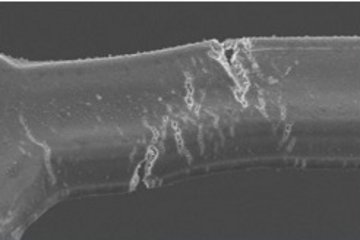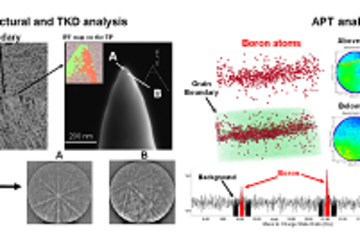All genres
181.
Journal Article
Massive interstitial solid solution alloys achieve near-theoretical strength. Nature Communications 13, 1102 (2022)
182.
Journal Article
Revisiting stress-corrosion cracking and hydrogen embrittlement in 7xxx-Al alloys at the near-atomic-scale. Nature Communications 13, 4290 (2022)
183.
Journal Article
Making sustainable aluminum by recycling scrap: The science of “dirty” alloys. Progress in Materials Science 128, 100947 (2022)
184.
Journal Article
Hydrogen/ Deuterium Detection in Ferrite-Austenite Dual Phase Steels. Microscopy and Microanalysis 28 (S1), pp. 1662 - 1663 (2022)
185.
Journal Article
Status and Direction of Atom Probe Analysis of Frozen Liquids. Microscopy and Microanalysis 28 (4), pp. 1150 - 1167 (2022)
186.
Journal Article
Mechanisms of austenite growth during intercritical annealing in medium manganese steels. Scripta Materialia 206, 114228 (2022)
187.
Journal Article
Exceptional Soft Magnetic Properties of an Ordered Multi-principal Element Alloy with Disordered Nanoprecipitates. High Entropy Alloys & Materials (2022)
188.
Journal Article
On strong-scaling and open-source tools for analyzing atom probe tomography data. npj Computational Materials 7 (1), 21 (2021)
189.
Journal Article
Revealing atomic-scale vacancy-solute interaction in nickel. Scripta Materialia 203, 114036 (2021)
190.
Journal Article
Corrigendum to Revealing atomic-scale vacancy-solute interaction in nickel (Scripta Materialia (2021) 203, (114036) (S135964622100316X), (10.1016/j.scriptamat.2021.114036)). Scripta Materialia 205, 114213 (2021)
191.
Journal Article
High diffusivity pathways govern massively enhanced oxidation during tribological sliding. Acta Materialia 221, 117353 (2021)
192.
Journal Article
Chemical heterogeneity enhances hydrogen resistance in high-strength steels. Nature Materials 20, pp. 1629 - 1634 (2021)
193.
Journal Article
Aluminum depletion induced by co-segregation of carbon and boron in a bcc-iron grain boundary. Nature Communications 12, 6008 (2021)
194.
Journal Article
Hydrogen and deuterium charging of site-specific specimen for atom probe tomography. Open Research Europe 1, 122 (2021)
195.
Journal Article
Discovery and Implications of Hidden Atomic-Scale Structure in a Metallic Meteorite. Nano Letters 21 (19), pp. 8135 - 8142 (2021)
196.
Journal Article
Open and strong-scaling tools for atom-probe crystallography: high-throughput methods for indexing crystal structure and orientation. Journal of Applied Crystallography 54 (Pt 5), pp. 1490 - 1508 (2021)
197.
Journal Article
Reactive wear protection through strong and deformable oxide nanocomposite surfaces. Nature Communications 12 (1), 5518 (2021)
198.
Journal Article
Dopant-segregation to grain boundaries controls electrical conductivity of η-type NbCo(Pt)Sn half-Heusler alloy mediating thermoelectric performance. Acta Materialia 217, 117147 (2021)
199.
Journal Article
Twins – A weak link in the magnetic hardening of ThMn12-type permanent magnets. Acta Materialia 214, 116968 (2021)
200.
Journal Article
CALPHAD-informed phase-field modeling of grain boundary microchemistry and precipitation in Al–Zn–Mg–Cu alloys. Acta Materialia 214, 116966 (2021)











